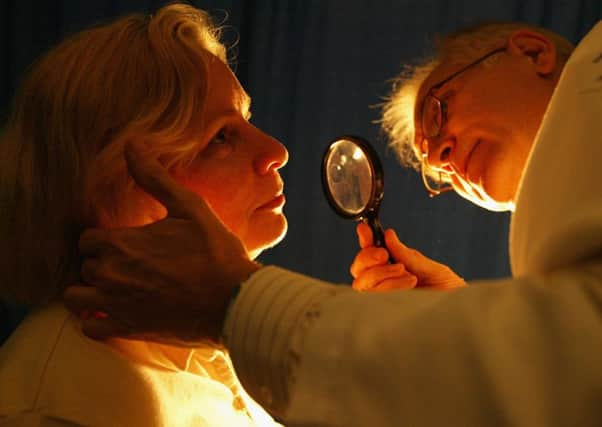Count moles on right arm to predict skin cancer risk


Experts say they have found a new way for GPs to quickly assess whether a patient may be at risk of developing melanoma.
Counting moles in a “proxy” body area such as the arm is a good marker for spotting potential problems, according to King’s College London researchers.
Advertisement
Hide AdAdvertisement
Hide AdAround 20-40 per cent of melanoma is thought to arise from pre-existing moles and having more than 100 moles on the body is a “strong predictor”.
Latest NHS figures show skin cancer cases in Scotland rose by more than 30 per cent in the past decade. There were 1,172 diagnoses of melanoma in 2013, making it the sixth most common form of the disease.
The study, funded by the Wellcome Trust, examined data from 3,594 female twins.
Specially trained nurses from St Thomas’ Hospital, London, performed a mole count on 17 areas the body, also recording skin type, hair and eye colour and freckles.
The results were checked against a further study involving men and women.
Scientists found the mole count on the right arm was most predictive of how many moles were on the entire body.
People with more than seven moles on their right arm had nine times the risk of having more than 50 moles on the whole body.
Those with more than 11 on their right arm were more likely to have over 100 moles on their body which researchers said was a strong predictor of risk for melanoma.
Advertisement
Hide AdAdvertisement
Hide AdThe experts found the area above the right elbow was particularly predictive of the total body mole count.
The legs were also strongly linked with the total count, while men’s backs also highlighted an increased risk.
Lead author Simone Ribero, of the department of twin research and genetic epidemiology, said: “The findings could have a significant impact for primary care, allowing GPs to more accurately estimate the total number of moles in a patient extremely quickly via an easily accessible body part. This would mean that more patients at risk of melanoma can be identified and monitored.”
The research was published in the British Journal of Dermatology.
Dr Claire Knight, health information manager at Cancer Research UK, said: “Other risk factors for melanoma include having red or fair hair, fair skin, light-coloured eyes or having been sunburnt in the past.
“But less than half of melanomas develop from existing moles. So it’s important to know what’s normal for your skin and to tell your doctor about any change in the size, shape, colour or feel of a mole or a normal patch of skin.”
CASE STUDY
Hazel saw changes in mole while in the bath
Hazel Carnegie first noticed a mole on her leg looked different three years ago when she was having a bath.
“If I’d been in the shower I may not have been aware of it,” said Ms Carnegie, 68, from Aberdeen. “It had changed colour and got a bit darker and blotchy. But it hadn’t changed size and it wasn’t itchy or sore.
Advertisement
Hide AdAdvertisement
Hide Ad“I knew enough about moles and skin cancer to go to my GP and was very lucky as she didn’t quibble and sent me to the dermatology department at Aberdeen Royal Infirmary.”
Ms Carnegie, a retired field worker for the Scottish Agricultural College, said she was surprised as she had never been a “sun worshipper”.
The mole proved cancerous and was removed.